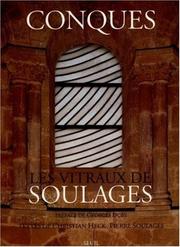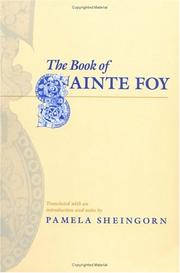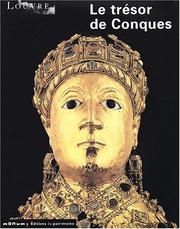| Listing 1 - 8 of 8 |
Sort by
|
Book
Year: 1934 Publisher: Rouen: Lestringant,
Abstract | Keywords | Export | Availability | Bookmark
 Loading...
Loading...Choose an application
- Reference Manager
- EndNote
- RefWorks (Direct export to RefWorks)
Book
ISBN: 2951260407 9782951260405 Year: 1998 Publisher: Saint-Jean-de-Védas Graphisme et couleur
Abstract | Keywords | Export | Availability | Bookmark
 Loading...
Loading...Choose an application
- Reference Manager
- EndNote
- RefWorks (Direct export to RefWorks)
Book
ISBN: 9788028004255 8028004253 Year: 2023 Publisher: Brno : Masarykova univerzita,
Abstract | Keywords | Export | Availability | Bookmark
 Loading...
Loading...Choose an application
- Reference Manager
- EndNote
- RefWorks (Direct export to RefWorks)
Conques --- Fides v. m. Aginni --- Miracles --- Reliquaires --- Architektur --- Bauplastik --- Religiöse Kunst --- Reliquiar --- Sainte-Foy --- Christian art and symbolism --- Church architecture --- Church decoration and ornament --- Pilgrims and pilgrimages --- Conques (Aveyron, France) --- Religious life and customs

ISBN: 202022593X 9782020225939 Year: 1994 Publisher: [Paris] : Seuil,
Abstract | Keywords | Export | Availability | Bookmark
 Loading...
Loading...Choose an application
- Reference Manager
- EndNote
- RefWorks (Direct export to RefWorks)
Religious architecture --- Applied arts. Arts and crafts --- Soulages, Pierre --- Conques --- Glass painting and staining --- History --- Criticism and interpretation --- Sainte-Foy de Conques (Church) --- Conques (Aveyron, France) --- Buildings, structures, etc --- Catalogs --- Abbatiale Sainte-Foy de Conques --- Stained glass windows --- Vitraux --- Peinture sur verre --- Soulages, Pierre, --- Oeuvres --- Vitraux. --- Glass painting and staining - France - Conques (Aveyron) - History - 20th century --- Soulages, Pierre - Criticism and interpretation --- Conques (Aveyron, France) - Buildings, structures, etc --- 748.5 --- 748.5 Glasschilderkunst. Glas in lood. Decoratieve ramen --- Glasschilderkunst. Glas in lood. Decoratieve ramen
Book
ISBN: 9782503541181 2503541186 Year: 2015 Volume: 7 Publisher: Turnhout Brepols
Abstract | Keywords | Export | Availability | Bookmark
 Loading...
Loading...Choose an application
- Reference Manager
- EndNote
- RefWorks (Direct export to RefWorks)
This book investigates the origins and transformations of medieval image culture and its reflections in theology, hagiography, historiography and art. It deals with a remarkable phenomenon: the fact that, after a period of 500 years of absence, the tenth century sees a revival of monumental sculpture in the Latin West. Since the end of Antiquity and the "pagan" use of free-standing, life-size sculptures in public and private ritual, Christians were obedient to the Second Commandment forbidding the making and use of graven images. Contrary to the West, in Byzantium, such a revival never occurred: only relief sculpture – mostly integrated within an architectural context – was used. However, Eastern theologians are the authors of highly fascinating and outstanding original theoretical reflections about the nature and efficacy of images. How can this difference be explained? Why do we find the most fascinating theoretical concepts of images in a culture that sticks to two-dimensional icons often venerated as cult-images that are copied and repeated, but only randomly varied? And why does a groundbreaking change in the culture of images – the 'revival' of monumental sculpture – happen in a context that provides more restrained theoretical reflections upon images in their immediate theological, liturgical and artistic contexts? These are some of the questions that this book seeks to answer.
Art figuratif --- Beeldhouwkunst [Franse ] --- Beeldhouwkunst [Middeleeuwse ] --- Christelijke heiligen in de kunst --- Christelijke heiligen--Iconografie --- Christelijke heiligen--Kunst --- Christelijke iconografie --- Christian saints in art --- Christian saints--Art --- Christian saints--Iconography --- Figuratieve kunst --- Figuration --- Figurative art --- Golden image of Ste Foy (Statue) --- Heiligen [Christelijke ]--Iconografie --- Heiligen [Christelijke ]--Kunst --- Iconografie [Christelijke ] --- Iconographie chrétienne --- Majesté de sainte Foy (Statue) --- Reliquary of St Foy (Statue) --- Saint Faith (Statue) --- Sainte Foy (Standbeeld) --- Sainte Foy (Statue) --- Saints chrétiens dans l'art --- Saints chrétiens--Art --- Saints chrétiens--Iconographie --- Sculpture [French ] --- Sculpture [Medieval ] --- Sculpture française --- Sculpture mediévale --- St. Faith (Statue) --- Statue der heiligen Fides --- Statue reliquaire de Sainte Foy --- Statue-reliquaire de Sainte Foy --- Christian art and symbolism --- Religious articles --- Sculpture, Medieval --- Art et symbolisme chrétiens --- Objets religieux --- Sculpture médiévale --- Foy, --- Sainte-Foy de Conques (Abbey) --- Image (Theology) --- Catholic Church --- Sculpture, Medieval. --- Christianity and art --- Figurative art. --- Catholic Church. --- St. Faith (Statue). --- Saints chrétiens dans l'art --- Art et symbolisme chrétiens --- Sculpture médiévale --- Foy --- Art --- Christian art and symbolism. --- Image (Theology) - Catholic Church --- Christian art and symbolism - Medieval, 500-1500 - Europe --- Christian art and symbolism - Medieval, 500-1500 - France --- Foy, - Saint, - approximately 290-303
Film
Abstract | Keywords | Export | Availability | Bookmark
 Loading...
Loading...Choose an application
- Reference Manager
- EndNote
- RefWorks (Direct export to RefWorks)
Ce DVD contient 6 épisodes de la série "Architectures". Chaque film analyse un bâtiment à travers des prises de vue réelles, des plans, des maquettes, et en retrace l'histoire tout en le situant dans le contexte de la production architecturale de son époque :1-La Saline d'Arc et Senans :La Saline d'Arc construite entre 1775 et 1779 par Claude-Nicolas Ledoux est une utopie architecturale qui a servi de référence aux plus grands architectes modernes, de Gropius à Le Corbusier...elle représente une révolution en architecture, une décennie avant la Révolution tout court. Ledoux veut réinventer l'architecture, comme Rousseau veut réinventer le Contrat Social en revenant aux sources, aux "principes naturels"2-La Maison de Verre :En 1928, l'architecte Pierre Chareau rénove un petit imeuble du 7e arrondissement de Paris et le transforme en habitation ultramoderne en pavés de verre. Enveloppe translucide, conception spatiale sophistiquée, fluidité du plan et assemblage judicieux des espaces publics et privés caractérisent cette maison.Achevée en 1931 par l'architecte Pierre Chareau (en collaboration avec Bernard Bijvoet), la maison de verre comporte, au rez-de-chaussée, le cabinet du docteur Jean Dalsace, commanditaire de la maison et ami de l'architecte. La maison a été inscrite sur l'Inventaire supplémentaire des monuments historiques en 1965 et classée en 1982. La restauration est menée comme un chantier de fouilles, avec l'idée que cette démarche archéologique de restitution ne doit pas entraver la vie quotidienne de la maison et les aménagements nécessaires à l'évolution du cadre de vie.3-Le Musée Guggenheim de Bilbao :Le musée Guggenheim de Bilbao est surprenant. Construit sur le site d'une ancienne usine à bois, cette sculpture géante surplombe la ville. Au bout de la rue, ou au détour du fleuve, une sculpture plus haute que les immeubles brille au soleil ou sous la pluie. Son volume est à la mesure du site, dont il constitue le pivot. Le pont autoroutier traverse le bâtiment ; la rivière baigne les fondations. A la fois baroque et fonctionnel, le volume d'ensemble est un enchevêtrement de formes courbes, qui se déploient, fusionnent, s'élèvent dans le ciel, s'allonge sous le pont. Un paysage chaotique au premier abord, des canyons, des blocs suspendus. Une composition animale.4-La maison de Jean Prouvé :Construite avec des éléments préfabriqués, la maison de Jean Prouvé à Nancy ouvre l'ère des maisons individuelles à bas prix. Ingénieur autodidacte, architecte sans diplôme, Jean Prouvé est né en 1901. Dans une France où le béton est roi, Prouvé est l'homme du métal, de la tôle pliée puis de l'aluminium. Dès les années 30, il conçoit plusieurs modèles de maisons individuelles à bas prix, en kit et à monter soi-même, prêtes pour la fabrication en série. Mais aucun de ces prototypes ne débouche sur de véritables commandes. La France de la pierre et du béton trouve trop modernes, trop simples ce qu'on appelle alors dédaigneusement des machines à habiter. En 1953, Prouvé perd le contrôle de son usine, l'œuvre de sa vie. Il se lance alors dans la construction de sa propre maison, sur un terrain situé sur les hauteurs de Nancy, réputé inconstructible à cause de sa très forte pente.5-La médiathèque de Sendaï :À 300 kilomètres de Tokyo, une médiathèque tout en tubulures et en transparence. Bâtiment traversé par des tubes aux motifs ajourés, tordus ou inclinés, la médiathèque de Sendaï (1995-2001) rompt avec les tendances de l'architecture du XXe siècle. Défiant toutes les lois de la construction, cette structure est pourtant à l'épreuve des pires séismes. Pour accueillir les différentes bibliothèques, l'espace public et les galeries d'exposition, Toyo Ito a conçu sept minces plateaux tous aménagés de manière singulière selon leur fonction. Malgré cette diversité, un seul principe régit le bâtiment : l'espace ouvert...6-L' Abbatiale Sainte Foy de Conques :L'abbatiale de Conques est l'un des ouvrages les plus importants construits dans la France du XIe siècle. Sa cohérence, son site (un petit village du Rouergue à l'écart des grands axes de circulation médiévaux), son aspect novateur et son état de conservation en font le meilleur exemple pour aborder l'architecture romane en France. Stan Neumann explore le bâtiment non sans démonter au passage quelques idées reçues à propos de l'art roman. À commencer par son appellation même, qui est une construction intellectuelle du XIXe siècle. Pour dire les choses autrement : ceux qui ont construit Conques ne pensaient pas faire de l'art roman, mais de l'architecture contemporaine...
Médiathèque --- Histoire de l'architecture --- Monumentalité --- Plan semi-circulaire --- Pavé de verre --- Aluminium --- Vitrail --- Flexibilité interne --- Lumière --- Patrimoine architectural --- Patrimoine industriel --- Bardage --- Façade --- Déconstructivisme --- Architecture religieuse --- Architecture romane --- Verre --- Bâtiment industriel --- Analyse de bâtiment --- Architecture néoclassique --- Église --- Musée --- Maison individuelle --- Maison d'architecte --- Conques --- Église abbatiale Sainte-Foy --- Arc-et-Senans --- Saline royale --- Nancy --- Japon --- Sendai --- Bilbao --- Espagne --- Paris (France)

ISBN: 0812215125 0812232836 9786613210999 1283210991 0812200527 0585172269 9780812215120 Year: 1995 Publisher: Philadelphia : ©1995 University of Pennsylvania Press,
Abstract | Keywords | Export | Availability | Bookmark
 Loading...
Loading...Choose an application
- Reference Manager
- EndNote
- RefWorks (Direct export to RefWorks)
The miracle stories surrounding Sainte Foy form one of the most complete sets of material relating to a medieval saint's cult and its practices. Pamela Sheingorn's superb translation from the Medieval Latin texts now makes this literature available in English. The Book of Sainte Foy recounts the virgin saint's martyrdom in the third century (Passio), the theft of her relics in the late ninth century by the monks of the monastery at Conques (Translatio), and her diverse miracles (Liber miraculorum); also included is a rendering of the Provençal Chanson de Sainte Foy, translated by Robert L. A. Clark. The miracles distinguish Sainte Foy as an unusual and highly individualistic child saint displaying a fondness for gold and pretty things, as well as a penchant for playing practical jokes on her worshippers. In his record of Sainte Foy, Bernard of Angers, the eleventh-century author of the first parts of the Liber miraculorum, emphasized the saint's "unheard of" miracles, such as replacing missing body parts and bringing dead animals back to life. The introduction to the volume situates Sainte Foy in the history in the history of hagiography and places the saint and her monastery in the social context of the high Middle Ages. Sheingorn also evokes the rugged landscape of south central France, the picturesque village of Conques on the pilgrimage road, and, most important, the golden, jewel-encrusted reliquary statue that medieval believers saw as the embodiment of Sainte Foy's miracle-working power. In no other book will readers enjoy such a comprehensive portrait of Sainte Foy and the culture that nurtured her.
Old French literature --- Medieval Latin literature --- Christian church history --- Christian special devotions --- Christian child saints --- Enfants saints chrétiens --- Biography --- Biographie --- Foy, --- Conques (Aveyron, France) --- France --- Religious life and customs --- Vie religieuse --- Enfants saints chrétiens --- Child Christian saints --- Christian saints, Juvenile --- Child saints --- Christian saints --- Faith, --- Fe, --- Fede, --- Fides, --- Foy --- Getreu, --- Conques, France (Aveyron) --- Concas (France) --- Conques-en-Rouergue (France) --- Religious life and customs. --- Biography. --- Foy, sainte, 02..?-02..? --- Abbaye Saint-Sauveur-et-Sainte-Foy , Conques, Aveyron --- Fides v. m. Aginni

ISBN: 2858226636 2901785182 9782858226634 9782901785187 Year: 2001 Publisher: Paris : Editions du patrimoine,
Abstract | Keywords | Export | Availability | Bookmark
 Loading...
Loading...Choose an application
- Reference Manager
- EndNote
- RefWorks (Direct export to RefWorks)
plate [metal, visual works] --- Applied arts. Arts and crafts --- Conques --- Goldwork, Medieval --- Orfèvrerie médiévale --- Exhibitions --- Church plate --- Reliquaries --- Relics and reliquaries --- Containers --- Religious articles --- Shrines --- Communion plate --- Liturgical objects --- Plate --- Sainte-Foy de Conques (Abbey) --- Conques (Aveyron, France). --- Religious silver art --- Middle Ages --- plate [silver or gold tableware] --- Orfèvrerie médiévale --- Church plate - France - Conques (Aveyron) - Exhibitions. --- Reliquaries - France - Conques (Aveyron) - Exhibitions. --- Fides v. m. Aginni --- Iconographie --- Trésor
| Listing 1 - 8 of 8 |
Sort by
|

 Search
Search Feedback
Feedback About
About Help
Help News
News